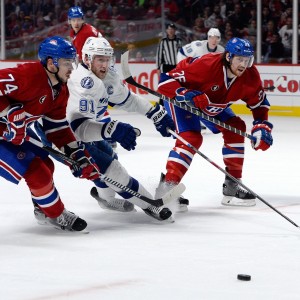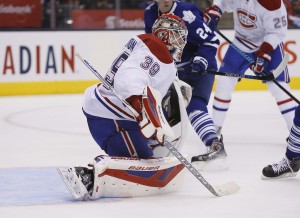Everything’s gone right for the Montreal Canadiens through the first 22 games of the 2015-16 season. Not only are the Habs in prime position to make the playoffs, but they’re also in great shape to win the division — they have a nine-point lead on the second-place Ottawa Senators.
Mind you, it’s still early, and there’s a long way to go before the Habs can lay claim to their second straight Atlantic Division title. From lucky bounces, to untimely injuries, to epic collapses, a lot can happen between now and the playoffs — just ask the Toronto Maple Leafs. Having said that, fans couldn’t have asked for a better start. The team is scoring, Carey Price is playing like Carey Price, and the Canadiens are already being touted as 2016 Stanley Cup contenders.
With Montreal now past the first quarter mark of the season, it’s time to give out grades. Without further ado, here’s the Habs’ interim report card.
Grading System
A Excellent
B Good
C Satisfactory
D Poor
F Failing
Note: Grades were based on expectations, performance and results.
Offense
Before their season-opener against the Leafs, it would’ve been crazy to suggest Montreal would be an offensive juggernaut this year; yet here we are, almost two months into the season, and the Canadiens lead the league with 78 goals scored (3.55 goals per game).
Heading into 2015-16, there were a lot of questions surrounding the Habs’ lack of goal scoring, and rightfully so. Last season, Montreal averaged just 2.61 goals per game, which ranked dead last among the 16 playoff teams. Luckily for the Canadiens, they had the league MVP in goal to counteract that. However, critics suggested the Habs were due for regression this season, and they had a point.
Price was coming off an off-the-charts performance in 2014-15, and to expect him to put up similar numbers in 2015-16 would’ve been a stretch. But there hasn’t been any regression — at least so far — and it’s because the Habs learned how to score.

As the chart indicates, the Canadiens’ even-strength shooting percentage is over one percent higher than it was last season. That may not seem like a lot, but over the course of a season, it makes a huge difference. For instance, had Montreal shot 9.36 percent at ES (even strength) last season, they would have scored 26 more goals. What sparked this sudden spike in shooting percentage?
Shot location.
When you compare last season’s shooting heat map to this season’s, it’s not hard to see why the Habs are having more success. Not only are they shooting more, but they’re getting to high-danger areas of the ice. The Canadiens are generating two more SCF60 (scoring chances for per 60 minutes) at even strength than they were last season. They’re also attempting four more shots per 60 minutes at even strength than in 2014-15. Shooting the puck more, and from high-percentage areas, means more goals. It’s simple math.
Remarkably, Montreal has eight players on pace for 20 or more goals. Will that continue? Probably not. But if the Canadiens keep playing the way they have been, they will undoubtedly remain a lethal offense through the course of the season. The team’s depth, combined with their upward trend in possession, has transformed their anemic offense into a powerhouse. Given the expectations heading into 2015-16, there’s no doubt what grade this much-improved offense deserves.
Grade: A+
Defense
There seems to be this idea that the Habs are among the best defensive teams in the NHL, and going by their goals against average the past few seasons, they are. But the underlying statistics suggest most of the Canadiens’ recent success defensively has been masked by great goaltending, and that still holds true today.
Anyone who thinks the Habs are ‘structured’ defensively should really explain what that means, because they’re very bad defensively.
— Andrew Berkshire (@AndrewBerkshire) November 20, 2015
This season, Montreal finds itself in the top five in goals against per game once again (2.23 goals against per game). There’s no arguing the results are there, but are those results reflective of the Canadiens’ defensive play?
Despite their impressive goals against average, the Canadiens still rank in the bottom 10 in SCA60 (scoring chances against per 60 minutes) at even strength. They’re also middle-of-the-pack in HSCA60 (high-danger scoring chances against per 60 minutes) at even strength, suggesting there really isn’t anything special about their defensive game.

Now, it’s not all bad. The Habs are in the top 10 in CA60 (shot attempts against per 60 minutes) at even strength, which is credit to their quickness and ability to prevent shooting opportunities. The Canadiens are known for their speed, and effectively use that to their advantage with and without the puck.
But given their knack for preventing shot attempts, it’s baffling that a large chunk of the shot attempts they do give up are scoring chances. Simply put, the Habs allow too much up the middle, and until they get that figured out, they will continue to be an average defensive team, at best.
Analysts preach Montreal is incredibly structured defensively, yet they’re one of the most exposed teams in dangerous areas of the ice. As much as the offense has improved, the defense has remained stagnant this year. Again, preventing goals is the main thing, and the Habs are doing a good job of it, but they’re still relying on goaltending a tad too much. I guess if you have the best goalie in the world, it’s OK to do that.
Grade: C
Goaltending
There’s not much to say here, so I’ll keep it brief.
Carey Price continues to prove why he was the 2014-15 Hart and Vezina Trophy winner. With a .933 save percentage and 2.10 GAA, Price is well on his way to another phenomenal season. While the Canadiens have proven they’re more than Price this season, there’s no question the 28-year-old goaltender is still Montreal’s best player.

But let’s not forget about the rookie who stepped in and played nine games in a row — no, that’s not a typo — in place of the injured Price. Mike Condon hadn’t played an NHL game prior to the 2015-16 season. In fact, most people didn’t even know who he was, yet he was called upon to fill in for the reigning league MVP in a city that lives and breathes hockey. He passed with flying colors, playing with incredible poise and helping Montreal to a solid 5-2-2 record in that span.
An evident upgrade from Dustin Tokarski, Condon now solidifies the Habs’ goaltending tandem and allows head coach Michel Therrien more flexibility to give Price periodic rests, particularly near playoff time; something he couldn’t do with Tokarski as backup.
Goaltending is one of the main reasons the Canadiens are so frustrating to play against. Even with the offense finding itself this season, the Habs will only go as far as Price takes them. So far this season, that looks like it could be pretty deep.
Grade: A